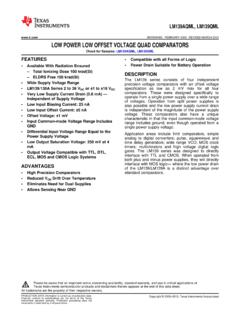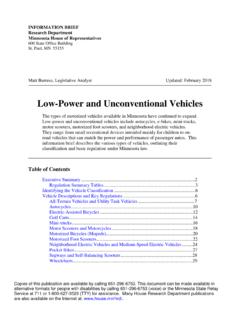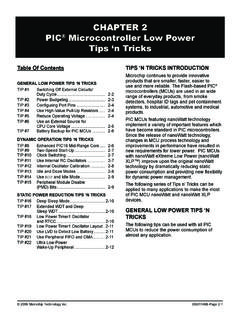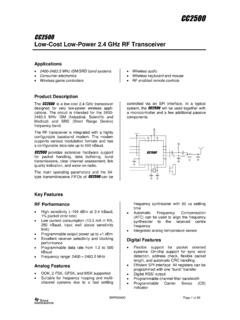Transcription of Sample Grant Proposal: REACH Low-Income Wind …
1 Sample Grant proposal : Low-Income Wind Energy Project Sample Grant proposal : Low-Income WIND power PROJECT Prepared by Community Consulting & Grant Writing This Sample Grant Narrative includes: Statement of Need o Overview o Target Population o Assumptions o Summary of Problems to be Addressed o Inclusion of Low-Income Families in Planning Process o Empowerment Zone / Enterprise Community Consideration Project Strategy o Philosophy o Mission o Final Goals o Interventions o Intermediate Outcomes o Significant and Beneficial Impact Project Design o Integration with other Programs o Partners and Roles o Coordination of Funding o Innovation o Work Plan and Time Line o Potential Problems This Sample Grant proposal is meant to be a model only. Your project will be unique. Use the ideas but not the text!
2 Sample Grant proposal : Low-Income Wind Energy Project 2 More Sample Grant Proposals Project Theory, Design and Plan The Big Picture: Future of Electricity in Washington Electricity prices will continue to rise as the electricity supply becomes more and more dependent on natural gas-fired turbines. In the 272 gas-fired plants are projected to be connected to the grid over the next decade. At the same time, domestic natural gas production is expected to peak in 2007, Canadian production in 2005, and Mexican production in 2011. Remaining natural gas reserves will be primarily in an unstable Middle East. (Rifkin, The Hydrogen Economy, 2002, p. 126-7) In this environment, a continued rise is in the market price of natural gas is almost inevitable. For this reason, it makes sense to shift to energy sources that are not subject to market pricing, to so-called cost-based resources.
3 Wind is such a source, and is abundant in Washington State. The price of wind-based energy is a function of the cost of wind-turbines and other infrastructure needed to develop a wind farm. Once these capital costs are paid, the energy source itself, wind, is free. In this sense, a wind farm is an insurance policy for Low-Income families against future volatility in the price of natural gas. This project builds on a foundation of partnerships, working with partner utilities to shift from treating the Low-Income community as passive consumers of power to active developers of power . By developing wind-generated electricity, the Low-Income community gains access to cost-based energy, escaping the fluctuations of the natural gas commodity market. Target Population The Project targets LIHEAP-eligible families heating with electricity.
4 According to a report prepared for DHHS by Roper ASW, there are 291,886 LIHEAP-eligible households in Washington State. Many of these households include members who are particularly vulnerable to heat or cold: 89,482 include an elderly person 73,051 include a disabled person 70,281 include a child five years old or younger These numbers are based on Washington s LIHEAP income limit of 125% of the Federal Poverty Guidelines. Using a 150% FPG standard approximately doubles each of the numbers above (663,034 households live below 150% FPG; of these 244,950 include an elderly person etc.). Last year, 57,300 households received LIHEAP, leaving 234,586 eligible households (80%) unserved. Because of historically low-priced hydro-electric power , most Washington Low-Income homes (73%) heat with electricity rather than natural gas (17%), with the balance using wood, oil, and other fuels.
5 Although Washington once had some of the lowest priced electricity in the nation, since 1980 rates have doubled, even after adjusting for inflation. (See Figure 1.) Sample Grant proposal : Low-Income Wind Energy Project 3 And from 1999 to 2002, residential rates saw a rapid surge of 20%. This understates the problem, because the rate increases have been disproportionate acoss the state, with some areas seeing significantly higher increases. For example, from October 2000 to the present, the largest public utility district in the state (Snohomish County PUD), increased residential rates by 50%. When rates move with such volatility, Low-Income families are likely to be left stranded . Middle and high-income families have been able to migrate to gas heat. Of new single-family residential construction, only 9% is all-electric, according to a June 11, 2003 article in the Seattle Post-Intelligencer.
6 And while 53% of Washington s homes heat with electricity (2000 US Census), fully 73% of Low-Income homes have electric heat. As often happens, Low-Income families have been left stranded in older housing stock, equipped for the energy markets of three decades ago. Converting electric-heated households to gas heat would seem to be a solution to electric rate volatility. And in fact, several programs in the state are taking this tack, including the state s LIHEAP program which can perform conversions when a household s heating system is in such bad shape that it must be replaced. However, such conversions are expensive and must be balanced with the need for energy assistance. A large conversion program was announced in June 2003 by Puget Sound Energy (PSE), the largest utility in the state.
7 PSE estimates that it will convert between 20,000 and 25,000 households from electric to gas. Given that the number of all electric households in Washington was placed at million by the 2000 US Census, even a large program is a drop in the bucket. The program is incentive-based, with $150 rebates on furnaces, $25 on gas heaters and free hook-ups. However a $175 incentive on a conversion that may cost $1500 to $2000 is too small to make a difference to many Low-Income families. Also, 73% of Low-Income families are renters. Typically, they are responsible for utility bills, so there is little incentive for landlords to convert rental units to gas heat. Sample Grant proposal : Low-Income Wind Energy Project 4 More Sample Grant Proposals Even if all Low-Income households could be converted to gas heat, the problem would not be solved: PSE just raised gas prices 18% in March 2003.
8 More and more, the gas and electric markets have become intertwined in Washington. Most of the new electric generation plants in Washington are gas-fired. As a result, natural gas prices have themselves become more volatile, and conversion to gas heat no longer provides the low-cost, stable utility bills that it once did. Increasingly, the cost of natural gas is linked to the cost of electricity. Figure 2 shows how natural gas prices at the Sumas Hub in Washington State have begun to track area electric prices. Even as residential energy costs are rising, Washington s employment outlook is darkening. A US Bureau of Labor Statistics report for April 2003 shows Washington with the second highest unemployment rate ( ) of any state. The national rate for the same period was Washington is being particularly hard hit by the loss of high-paying jobs at Boeing.
9 Because of cut-backs in the airline industry since the terrorist attacks of September 11, 2001, Boeing has been forced to lay-off 33,890 workers over the past 19 months and plans further cuts (Seattle P-I, ). Boeing is also facing stiffer competition. On June 20, 2003 the AP reported, European plane manufacturer Airbus won a $ billion order for up to 32 wide-body planes from Gulf carrier Qatar Airways yesterday, snatching another deal from last week, the airline was considering its first purchase of Boeing planes. Because Boeing is such a large employer in the Puget Sound area, the loss of these high-paying jobs has a negative ripple effect throughout the area. And so Low-Income electric-heating households are caught between rising electric rates and negative job growth. At the same time as companies like Boeing are downsizing, one industry in Washington State is poised for growth: wind energy.
10 A recently completed wind map shows that Washington compares favorably with other states in available wind resources (see Figure 3 below; a more Sample Grant proposal : Low-Income Wind Energy Project 5 More Sample Grant Proposals detailed wind map is included as Appendix K). In Walla Walla County, the State Line Project (the largest wind project in the world) has shown that wind power is competitive with fossil fuels. Technology and cooperative buying power have brought down the cost of wind turbines. State and federal legislation have increased incentives for developing renewable power sources. The wind industry is primed for rapid growth. Assumptions There are several assumptions we have made about the needs of our target population and the economic environment around them.





